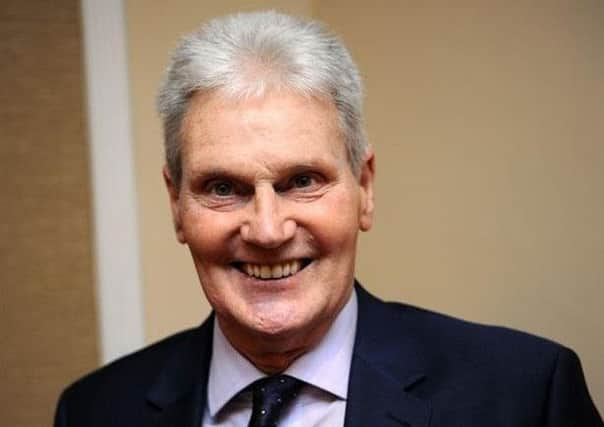Obituary: Roger Hynd, former Rangers player and PE teacher


Roger Hynd, who has died from cancer, was minor Scottish football royalty – his mother was Bill Shankly’s sister. Compared to his legendary Uncle Willie, Roger was a football journeyman, and he was something Uncle Willie respected, but struggled to understand – a footballer whose brains were in his head.
Roger showed his footballing ability at Lanark Grammar School, where he was a member of the school team which, in 1959 brought the giant Secondary Shield to the school for the first time. One of his teammates in that side was future Hibs Chairman and Hampden “blazer” Lex Gold and he, Hynd and Alex Brookes of that successful Lanark GS team were all signed by Rangers, although only Roger reached the first team.
Advertisement
Hide AdAdvertisement
Hide AdAs he served what was then an obligatory lengthy apprenticeship in the Ibrox reserve side, Roger was laying the groundwork for a life after football, attending the Scottish School of Physical Education at Jordanhill College, where he qualified to teach PE.
Graduating from Jordanhill, Roger put his teaching career on hold to go full-time with Rangers, making the first of an eventual 50 first-team appearances at left back in a 3-0 Ibrox win over St Mirren, on 12 October, 1963. He was never more than a squad player with the club and the only medals he won were as part of a Rangers Youth team which did a league and cup double, prior to the match, that is, for which he is best remembered.
Rangers were beaten by Berwick Rangers in the Scottish Cup on 28 January, 1967. This sent shockwaves through Scottish football and Jim Forrest and George McLean, the club’s two principal strikers, who had between them scored over 30 goals that season were dropped, and within weeks ha left the club. Forrest’s cousin, Alex Willoughby, stepped up, scoring 16 goals between February and the end of the season, but the belief was that Rangers badly needed a big centre forward to contrast with the slight Willoughby. So for the second leg of the semi-final of the European Cup-Winners Cup, against Slavia Sofia, at Ibrox on 3 May, 1967, Hynd, who had been on the transfer list at the start of the season, and who had scored four goals in a 5-2 Reserve team win over Dundee on the previous Saturday, was given the number nine shirt.
He kept his place for the final league game of the season, against new Champions Celtic, at Ibrox on the Saturday, scoring Rangers’ equaliser in a 2-2 draw, before going on to wear the number nine jersey again as Rangers lost in extra time to Franz Beckenbauer, Sepp Maier, Gerd Muller and the other Bayern Munich legends in the Cup-Winners Cup Final, in Nurembourg.
His Ibrox career ended in 1969 when he went south to Crystal Palace. He spent just a season at Selhurst Park, before Birmingham City manager Freddie Goodwin persuaded him to switch to St Andrew’s, where he enjoyed the best spell of his football career.
In five seasons with Birmingham, he played over 200 games as the team was promoted from the Second Division (today’s Championship) and also reached the FA Cup semi-final in 1972 and became club captain. His sterling service to the club was recognised in 2012 when he was elected to the Birmingham City Hall of Fame and he always enjoyed returning to the Midlands, where he was a figure much-loved by the City fans.
He had a short spell on loan at Oxford United, running down his playing career with Birmingham’s near neighbours Walsall, before hanging up his boots after over 400 first-team games for his five clubs. He returned to his adopted Lanarkshire to succeed Willie McLean as Motherwell manager. He was in the hot seat at Fir Park for a little over a year, and while the team did not set the heather on fire, sixth place in the Premier Division wasn’t too shabby a record. The team failed to kick on at the start of the next season and Hynd resigned, allowing Ally MacLeod to come in and oversee relegation.
He had one further excursion into management, as caretaker boss with St Johnstone, before he turned his back on professional football to finally use his PE teaching qualifications. Remaining in Lanarkshire, he taught PE at Dalziel High School, Coltness High School and Garrion Academy, before retiring.
Advertisement
Hide AdAdvertisement
Hide AdAway from football, he was a quiet family man, a keen fly fisherman, while his prowess on the trombone, as a member of a brass band, had taken him to the heights of the National Brass Band Championships at the Royal Albert Hall. Sadly, his retirement years were blighted with the diagnosis of Multiple Myloma cancer in 2009. He battled the disease with all the courage he had shown on the football field, raising awareness of his illness and being a prominent spokesman for the Prince and Princess of Wales Hospice.
His cousin, Blyth Mitchell, said: “There was no self-pity about Roger, he accepted his illness and fought it bravely. He was also very concerned to maintain the Shankly and Glenbuck legacy and I remember one day, we were up at Glenbuck, looking over what the opencast operations had done to the village and we were both in tears. He will be sorely missed.”
The funeral is on 28 February. Roger is survived by wife Jane, sons Michael and Andrew and three grandchildren.
MATT VALLANCE